 klaus-michael schneider
klaus-michael schneider
Keywords: carabobo | guacara |
Links: FOTW homepage | search | disclaimer and copyright | write us | mirrors

Last modified: 2021-08-26 by  klaus-michael schneider
klaus-michael schneider
Keywords: carabobo | guacara |
Links: FOTW homepage |
search |
disclaimer and copyright |
write us |
mirrors
 image by Luis Manuel Lopez Rojas, 18 April 2020
image by Luis Manuel Lopez Rojas, 18 April 2020
See also:
Red represents the blood that the heroes spilled in the battle of Vigirima.
Yellow represents the wealth of our lands with cultivation, commerce and
industry.
Blue represents the waters that flow through the municipality.
Green symbolizes the vegetation, the agricultural lands, the flora and fauna of
the municipality.
The 3 stars symbolize the 3 parishes that make up the
municipality.
The Guacara symbol in the yellow triangle is the Goddess of
rain, representing the fertility of her lands.
Luis Manuel Lopez Rojas, 18 April 2020
An official website provides more detailed information on the flag.
The flag, designed by Jhoender José Rodriguez Castillo, was inaugurated on 20
February 2011.
The flag is horizontally divided red-blue-green with three
white stars in the center and a yellow triangle placed long the upper hoist,
charged with a representation of the Goddess of Rain.
The red stripe
represents blood shed by the heroes in the battle of Vigirima, strength,
struggle, force and Socialism.
On 20 November 1813, José Felix Ribas,
commanding troops mostly composed of his students and supplemented by forces
sent by Simón Bolívar, met the Royal troops commanded by Colonel Salomón heading
to Valencia. The Independentists won the battle after three days of fierce
fighting.
The blue stripe symbolizes the great quantity and diversity of
water available on the municipal territory, like the river [Guacara] and the
lake [Tacariguas / Valencia].
The three stars represent the parishes of
Guacara (urban parish, capital; 148,570 inh.), Ciudad Alianza (urban parish,
23,000 inh.) and Yagua (rural parish, 29,953 inh.). White is a symbol of peace,
love and kindness.
The green stripe means the beauty of the vegetation,
fertile lands used for agriculture, the wide and diversified range of trees and
flowers, and, most important, the inhabitants' love and commitment for natural
environment.
The yellow triangle represents the resources offered by
agriculture, commerce and industry.
The Goddess of Rain is the symbol of the
ancestors who designed it to represent the fertility of the soil and of the
archeological resources of the municipality.
http://smpna-guacara.blogspot.com/p/guacara.html
Guacara Directorate for
the Protection of the Youth
The Goddess of Rain is a hieroglyph (drawing
engraved in a rock) found in Vigirima, in the archeological megalithic site
protected today as the Archeological Park of Painted Stones and included in the
San Esteban National Park. The hieroglyphs, dated from 4500 to 1000 BC, were
designed by Arahuaco living near Lake Akeúna (Valencia), whose water was thought
to confer eternal life.
The Goddess of Rain was named and presented for the
first time in 1939 by Luis Oramas during the 27th International Americanist
Congress held in México. Considered as the best piece of rock art found in
Venezuela, the Goddess of Rain was subsequently widely popularized and studied.
Omar Idler provided its definitive, accurate, representation in his book
dedicated to the Guaraca hieroglyphs ("Petroglifos de Tacarigua", 1985).
http://www.rupestreweb.info/diosalluvia.html
Leonardo Páez. 2008. La
diosa de la lluvia o fertilidad: su documentación a través del tiempo.
Rupestreweb
Ivan Sache, 19 April 2020